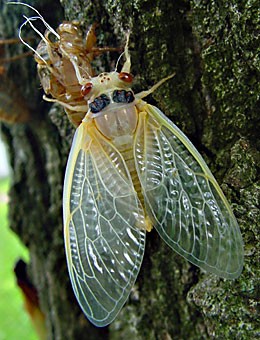The trees are alive with the sound of … mating cicadas?
Cicadas are what cause all that loud buzzing during the hottest part of the day in summer, said Carl “”Bug Man”” Olson, a UA entomologist and lecturer.
But the phenomenon is not restricted to just noise.
The sound people hear coming from the trees is of often made from one male cicada trying to catch the attention of any females in the area, he said, though in some species, all of the males will congregate in one tree to maximize their volume.
Female cicadas are silent, Olson added.
The insect only sings at the highest daily temperatures as a defense mechanism, he said, as most predators rest during the highest heat.
The buzzing from bushes and other plants at night is not from cicadas, he added, and are probably katydids or crickets.
The high volume of its mating call is another defense mechanism, Olson said. Birds avoid hunting for the bugs while the sound is so loud, instead waiting until dawn or dusk to try to catch a treat.
Tony Pulido, a pre-public health senior, said the sound is “”kind of annoying,”” though the behavior of the mating males is somewhat reminiscent of human males.
“”Guys tend to be more outgoing and try to be ‘look at me’ and try to get a girl’s attention,”” Pulido said.
Terri Shay, a fine arts senior, said that the sound is one of the “”most amazing”” things about the cicada.
“”I’m totally impressed by the amount of sound they can put out,”” Shay said. She added that was also impressed by the fact that it only takes one male to make such a sound.
Shay said cicadas don’t bother her like they do others, though she said she does not like it when they fly at her.
Shay, whose art concentration is three-dimensional art, has created sculptures with insect themes.
“”I do these insect chalices because insects are underrated,”” she said.
Cicadas have had a long history of mistaken identity.
Some people call them locusts, Olson said, but that is due more to the large, sudden populations of some species, some of which stay below ground for 17 years before erupting all at once. Some people associate the process with Bible stories, rather than the shape of the insect.
Cicadas are closely related to aphids, but are just much larger, he said.
In a photograph comparison, it seems that the cicada has a wider body than a locust, its legs are shorter and its wings look more like those of butterflies.
For a long time, monarchies of France were thought to have had the bee as their oldest emblem, according to the insect Web site http://www.insectvista.com, but it was realized later that the so-called bees were actually cicadas.
Throughout the ancient world, the cicada was revered.
In Greece, they were kept as pets, and in China, jade carvings of the insect were buried with the dead in hopes that it would cause the deceased to rise again or to be reincarnated, according to the Web site.
Olson said that the cicada has gotten a bad reputation, having been blamed for destruction of trees, even though the cicada is actually good for the ecosystem.
When the cicada finally mates, the female lays her eggs in a twig, then dies, along with hundreds of thousands of other cicadas shortly thereafter, Olson said.
By the end of the monsoon season in Tucson, nearly all of the eggs have hatched, he said. Next, the immature insects fall down and burrow into the earth and stay there for 3-5 years, until they erupt in the late spring or summer.
What is good for the ecosystem is that some of the twigs in which the eggs were laid die and fall off the tree, Olson said. This acts as a natural pruning process.
“”Bugs are not plant killers per se,”” he added, pointing out that it would be illogical for insects to kill the plants with which they evolved and that they depend on.
“”If a plant dies (because of insects), you have to look at the health of the plant,”” Olson said.
For instance, though bark beetles were blamed for dying trees in the forest a few years ago, he said, it was really a situation of an overcrowded forest.
The glut of trees created a boom of bark beetles, he said. The beetles just did what came naturally.
Next came forest fires, which pushed back the beetle population.
“”Nature wants to take out the old and sick, and that’s what the beetles do,”” he said.
“”People don’t like it because they think it’s ‘their’ forest and they want it to stay the same,”” Olson added. “”Death is a natural fact.””









